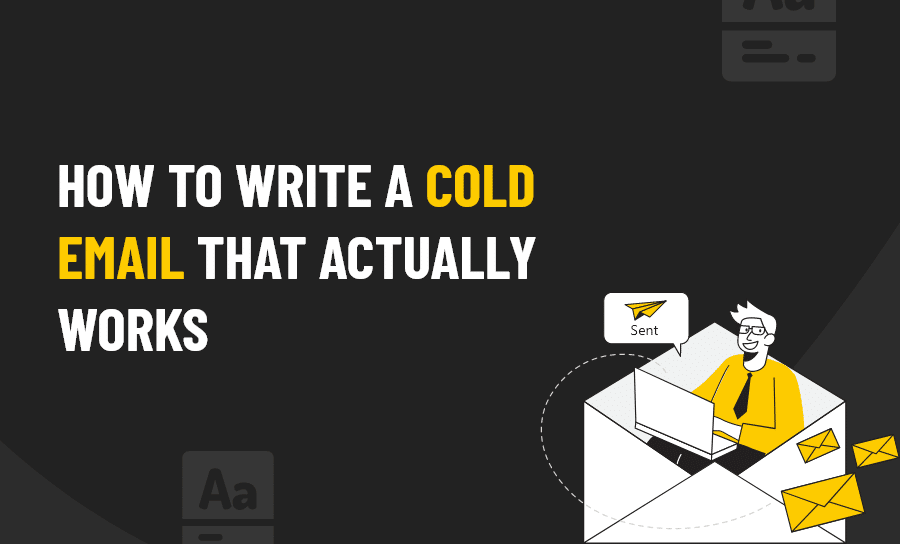Ready to skyrocket your sales? Taking the time to learn how to write a cold email that actually works will be critical for your success with cold email prospecting and lead generation.
Most people shy away from sending cold emails , because they think it’s spam and they don’t want to get that kind of reputation. But done right cold email ISN’T SPAM, and it could be just what you need to boost your bottom line, so taking the time to learn how to write a cold call email is an effort worth making.
Some have tried and failed. Believe me, I did when I first started out. In fact, I made almost every single mistake there is to make. And I did very few of the things I’m about to recommend here. I could never have advised anyone on how to send a cold email that works because at that point I barely knew myself.
But, I gradually tweaked and tweaked my approach to writing and sending cold emails until I figured out what works time and again. It helped me build my company into a seven-figure marketing and lead generation agency.
So, to save you going through quite as much trial and error – and embarrassment at being ignored again, here are some of the best tips I can offer for writing a cold email that works.
Subject Lines Matter
A subject line is the same as a text title of a blog post or article. It has to be catchy and attractive or your email will end up going unread and immediately sent to the trash. A catchy and concise subject line will help your cold email stand out from the crowd and get it noticed. Keep the subject line under 50 characters, because there is just no need need to tell the entire story there. You can even use a single word if it’s possible.
But, steer clear of truly spammy subject lines like DISCOUNT! DON’T MISS THIS GREAT OFFER! Subject lines like those turn potential readers off in an instant – because even if it’s not people will assume that the message behind the subject line is a spammy waste of their time. And so will many spam filters. You can also add a bit of personal touch by using the recipient’s first name in the subject line. It’s a way to make the whole thing a little warmer and friendly (yes, cold email should be warm and friendly)
Craft A Killer Opening Paragraph
Once your your message has been opened, you need it to be read in full– from start to finish. This is where a killer first paragraph comes into play. That first paragraph has to speak to the reader and pique their interest. It’s actually worth keeping in mind that many email clients are set to preview a portion of that first paragraph of the message, so make the first line as attractive as possible for your target audience.
Set The Right Tone Right Away
As you begin to write your cold email make sure you always include a reason why you have chosen that particular person as a recipient and why you think they are the right contact. It’s also a great thing to show some level of familiarity with their business or what they do. Doing so creates the impression that you’re thorough and serious about your work and what you are about to offer them.
When addressing the recipient – keep it casual. These days email communications – or any kind of communications- rarely include boring and old-fashioned forms of address and greeting, like Sir, Madam or Cordially. Stick to casual forms to give your cold email a more human, personal touch.
Here’s one way to do that: Write like you speak. Anyone who knows me knows that the following cold email – which is one I send out in one form or another quite often – sounds just like me. They’d recognise I wrote it before they saw the signature. And it may not be quite your style. But that’s okay, because your cold email needs to reflect what YOUR style is, not mine, and it will make a huge difference if it does.
The pleasure’s all mine {{first name}}
Main Body
Greetings {{first name}}/earthling
Hi, I’m Deepak a lovely British Indian that got your email from an even lovelier friend who ‘accrued’ it for me from LinkedIn….:p
So now we’ve got the awkwardness over with let me pitch you (woop woop)
I don’t know if this is a problem you have – but I can help….
Wait for it………:p
In such a competitive market, an SEO strategy is crucial for digital agencies that are looking to stay ahead of their competitors. There is one sure fire way to drive traffic to your website: Search Engine Optimisation
I run Pearl Lemon, an award-winning SEO agency (really) and would love to at this stage simply say ‘hello!’
Although you will rarely know the person you are cold emailing in anyway, making use of your real personality from the get go will help further down the line when people do reach out and actually speak to you. They’ll know you were being straight up from the start, something that will help build trust.
While we are on this subject, you may have read a lot about ‘the best cold email templates’. You may have seen a lot of them available for download. Those offering these templates will often claim that all you need to do is personalise them a little and you’ll create the ‘perfect’ cold call email. Don’t believe the hype. Savvy prospects know when they are being sent a generic, template email – possibly because they’ve seen it before – and will be far from impressed. Take the time to craft your own copy, I promise it will be time well spent.
Cold Email : Avoid Redundancy When Introducing Yourself
As you begin to decide how to start a cold email , you’ll need to cover the basics first. You need to tell the reader who you are, what your role in the company is and how you can help them. Make sure to include a few relevant details and links where your potential clients can read more if they want to. But, that’s about it. Don’t write at length about you, your job, aspirations and so on. They don’t know you and to be frank, they don’t really care (yet)
Be Specific About What You Want
Make sure that you state precisely what you need and what you expect the reader to do. Are you looking for a business partner or consultant? A connection on LinkedIn? Are you selling a product? People shouldn’t have to guess what you need.
If you’re offering a product or service, your cold email should include a link to your corporate website for additional product details, benefits, advantages, etc. Don’t stuff the email itself with too many product details, entice the reader to click through and explore themselves instead.
Prove You Don’t Pose a Risk
Risk is one of the inherent elements of doing business and therefore one of the biggest obstacles to selling anything. Your email needs to give your potential new clients a sense of safety and a reason to respond. People are rarely willing to take the risk of becoming the first client or customer of someone who has zero track record or reputation.
That means you’ll have to include at least a few words about your successful cooperation with another client and the results you have achieved. This way, you will be perceived as less of a risk and the reader will be more inclined to make that ‘leap of faith’ and give you and your business a shot.
Make It Easy for Your Reader to Respond
Whether you want to meet in person, communicate via email, over the phone or have a Skype chat, the most important thing is to make it easy for your recipient to respond. Craft your call-to-action in a way that speaks directly to something that she would be (genuinely) interested in, and make it easy to say “Yes.”
Make Sure They Get the Gist
People receive heaps of emails every day – and more than a bit of cold email in many cases, especially if they are a known decision maker (CEO, HR manager, VP etc.) so you have to make it easier for them to actually read your cold email. Don’t bury the essence of your message into a sea of vague sentences without a specific point. Keep your message brief, clear and concise. The reader should be able to grasp the purpose of your communication attempt and your expectations for where you’d like it go next without much effort.
Prove You CAN Deliver
The most effective cold email should create the impression that you are the best solution to one -or more – of the recipient’s problems. Briefly address the issue in question and suggest a solution. The point here is – make it easy for people to see the value in your offer. Making them realize that the email (and your future correspondence) can help them resolve an issue will increase the probability of getting a response.
In a nutshell, try to keep your emails short, sweet and simple. Maintain focus on your potential clients, not yourself. Show them you know what they need and convince them that your offer is the perfect choice.
Know Who You Are Addressing
When it comes to cold emailing, it’s important that you are as certain as possible that you are to be certain that you sending them to the right person. In fact it’s pretty much as important as the quality of the email itself. You can’t rely on the assumption that the person who gets the email will forward it to the right person if they are not. Therefore, it is crucial to find valid email addresses of your prospects while building an email list to make sure your emails are delivered to the right people.
Let’s say you need the person in charge of making advertising decisions. However, because you did zero research you send the email to the person in charge of company car maintenance. The car person is going to be confused – why the heck did this joker email them about advertising? – and it’s likely that the only way they will show the email to the advertising manager is as a bit of joke. Opportunity to connect, over.
Send your cold emails to personal addresses, not generic ones such as sales@xycompany.com or info@xycompany.com. Actually look for the names of the people you want to contact. Check the website of your target recipient’s company. Check LinkedIn and other social networks. Do some legwork.
Speaking of legwork your also need to do some quick research on the recipient’s company and, if possible, their personal interests. It will help you craft a cold email which will grab their interest. If people perceive your cold email as generic, you’ll never get a response. Always mention something specific about the company or the recipient to show why you have chosen to contact that particular person.
It’s Not About You, It’s About Them
When trying to push an offer, people tend to write too much about themselves in their initial cold email. This is one of the most common mistakes that people make in crafting cold email templates. Focus on the “customer” instead of writing about yourself. Show intent to help solve the recipient’s problems and needs, not your own.
Try to find shared interests with each one of the people that you plan on contacting. Add value to your email by mentioning said interests. Be confident that you have the answers to the recipient’s questions, but don’t try to oversell. You need to find a good balance to trigger people’s desire to respond to your cold email.
You can go out there on the web and find a bunch of cold email tips and cold email templates, ones which – it is claimed at least – have worked wonders for other people. But, never assume they’ll work for you as is. If it was that easy everybody would be sending cold emails that work every time, and that is just not what happens. Instead you need to do is develop templates that will work for you and your unique business.
Once you have that great template, you should carefully customize it to make it sound personal each time you email someone new. The more you personalize your emails, the better the odds that you’ll get the positive response you are looking for.
Keep It Short and Sweet
The first impression people get about your cold email comes from the subject line. Never write long or misleading subject lines. Announce clearly what people can expect after they open your email.
Nobody likes to read long and boring email messages, especially when they come from a person they have never met before. Keep your emails short. Try to say everything you have to say in 4 to 5 sentences, max. Be specific. Include a clear call to action. Let people know exactly what you expect from them.
You can’t say everything you want in one email, so don’t try to do this. Carefully select the information you consider relevant to share in your first cold email. Do not attach any documents. Briefly present your offer, tackling the main interest of the recipient, and ask for a response. It’s okay to send follow ups when you don’t get a response and in fact, that’s exactly what you should plan to do when you create your cold email plan.
Show Some Cred

Credibility is one of the key factors that will influence the recipient’s decision to respond – or even to read – to your cold email. You can’t expect anyone to be willing to do business with you if you can’t demonstrate some credibility.
Start by ensuring you only send emails from an address based on a business domain. Never send a cold email from Yahoo, personal Gmail or other generic e email services. As I was learning about what is a cold email I realised that obtaining a proper business domain email address was a must. If you cannot make use of one from your website directly invest in G Suite, Google’s suite of intelligent apps. It will give you the credible business email facilities you need and a lot more besides.
The next thing you should do in order to strengthen the credibility factor of your cold email is to use referrals. It’s easier for people to accept things which are referred by close friends, colleagues or even mere acquaintances. So, use referrals every time you have the chance. Social proof is another useful tool for demonstrating credibility in cold emails.
Remember to share your contact details and add a photo of yourself in the email signature. Make it easier for people to trust you. Let them know they are about to do business with a real person that has real solutions for them.
Another important aspect that you need to pay attention to is the language. Write conversational emails. Show that you’re confident, but don’t be arrogant. Also, remember to double-check the grammar, spelling, and punctuation. The smallest of errors can cause a lot of damage to the credibility of your message.
Nailing That CTA
How do you really measure the success of any cold email campaign? It is not the number of people who opened your email. Sure that is important . But it is really just a vanity metric. It is not the number of people who read your email all the way to the end and loved your thoughtful comments. (well done though.. seriously)
The real metric of success of a cold email campaign is the number of people who actually take the desired action based on your email. And that is why, even though I have just given you a lot of tips about how to write a great cold email if you chose only to listen to one piece of advice, make it this next one: Your CTA is everything.
Do you want your prospects to click a link on your email and visit your website/ landing page? Or do you want your prospects to signup for a free trial of your product?
In many cases, you may want them to hit the reply button and schedule a meeting with you. Or, you may simply want to start a friendly conversation.
All of these are valid motivations to send a cold email. And getting your prospects to complete that desired action, that is the specialty of your cold email Call to Action.
As your prospect scrolls down your email and reaches your call to action, she reaches that make or break moment. Whether to take the next action or relegate your email to the archives.
Add too much friction and you lose prospects who may have been interested. Don’t make it persuasive enough and you lose the opportunity to nudge those who are close to the finish line.
So what is the perfect CTA, just the right way to close an email to give you the best possible chance of actually getting the reader – your prospect – to do just what you want them to?
The simple, honest answer is that there isn’t one. Every business is different. every opportunity might be offering is different to someone else’s. But, there are some basics that, when you tweak them to suit your unique message can undoubtedly be far more successful than other CTA types. Here is a look at just a few of them to get you started.
Provide a Calendar Link
“Book a 15 min slot at your convenience and let’s talk about how we can help you grow your traffic. Here is a link to my calendar.”
This CTA works beautifully as an alternative the somewhat overused tactic of providing a specific date and time that you would ‘like to call’ that so many email marketers use (with very varied success rates)
Why? With the great new tools available to schedule appointments from an email freezing a mutually convenient date for a call has now become a breeze. No more back and forth conversations about choosing various dates, time zones, and options.
By providing your calendar link you are making it easier for the prospect to respond. All she has to do is just open the calendar and choose a date and time that suits her. Your prospect does not even need to hit reply and type out a response.
And what’s more, usually you can set up your calendaring service to send an automatic meeting reminder to both you and the prospect, again, in about half a click.
Reiterate your Value Proposition in the CTA

Which of these closing lines do you think is more likely to swing a prospect on the fence about whether he should speak to you.
Option 1: Are you free for a call tomorrow at 4 pm?
Option 2: Are you free for a call this Friday to discuss how you can increase your employee productivity?
Your Call to Action is another opportunity to reiterate your value proposition and gently persuade why your prospect should speak to you. By reiterating your value proposition, you are helping them connect the dots between various parts of your email. And summarizing it in one simple and distilled benefit statement.
Ask a Simple Yes/ No Confirmation Question
“Is fixing {pain point} a high priority for you now?…”
Present your prospect with a way to overcome a pain point and then ask a question to confirm if it is a problem they currently experience. Or provide a solution to a problem and then ask a question to confirm if fixing that problem is a priority.
Also, if you are able to reach prospects at the right time with the right confirmation question, then that feeling of ‘you know me, you get me’ will translate into a meaningful response.
So there you have it, a nice little start to your ‘mini career’ as a cold email marketing maestro. There is admittedly quite a lot more to learn if you want to achieve the big numbers I have, but these tips and pointers will get you off on the right foot.
faqs
Writing a cold email can be stressful because you want to make sure the recipient opens and trust your email. From there you also want them to act based on your email.
There are multiple templates out there to help with the process, all you have to do is search “how to write cold emails for sales” or “cold email how to make it work”. You will notice many techniques about being personal but not sounding like spam.
Here are some quick tips on how to write a cold email:
- Research your audience to tailor the message towards recipients
- Clarify who you are
- Provide a solution to the recipient’s problem
- Keep your email short but clear






